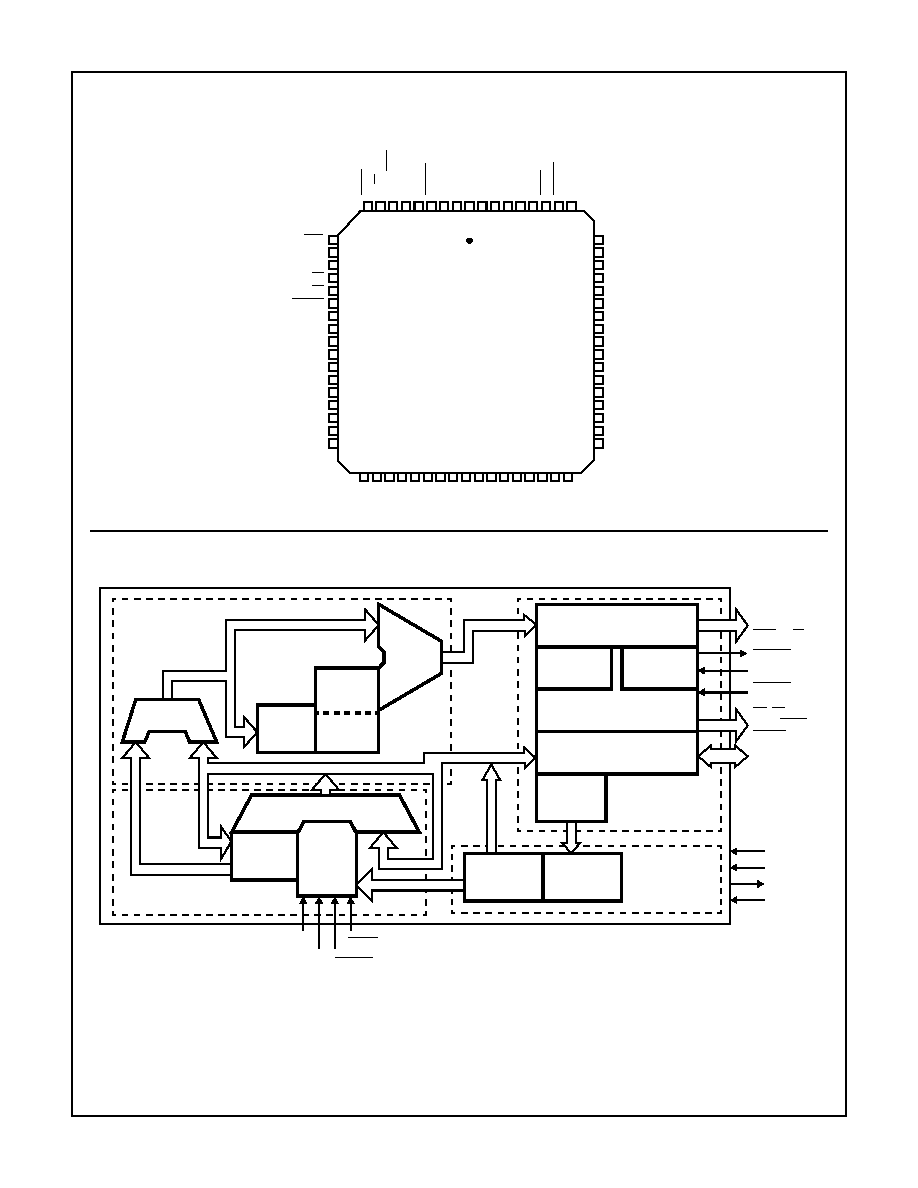
1
Æ
March 1997
80C286
High Performance Microprocessor
with Memory Management and Protection
Features
∑ Compatible with NMOS 80286
∑ Wide Range of Clock Rates
- DC to 25MHz (80C286-25)
- DC to 20MHz (80C286-20)
- DC to 16MHz (80C286-16)
- DC to 12.5MHz (80C286-12)
- DC to 10MHz (80C286-10)
∑ Static CMOS Design for Low Power Operation
- ICCSB = 5mA Maximum
- ICCOP = 185mA Maximum (80C286-10)
220mA Maximum (80C286-12)
260mA Maximum (80C286-16)
310mA Maximum (80C286-20)
410mA Maximum (80C286-25)
∑ High Performance Processor (Up to 19 Times the 8086
Throughput)
∑ Large Address Space
∑ 16 Megabytes Physical/1 Gigabyte Virtual per Task
∑ Integrated Memory Management, Four-Level Memory
Protection and Support for Virtual Memory and Operat-
ing Systems
∑ Two 80C86 Upward Compatible Operating Modes
- 80C286 Real Address Mode
- PVAM
∑ Compatible with 80287 Numeric Data Co-Processor
∑ High Bandwidth Bus Interface (25 Megabyte/Sec)
∑ Available In
- 68 Pin PGA (Commercial, Industrial, and Military)
- 68 Pin PLCC (Commercial and Industrial)
Description
The Intersil 80C286 is a static CMOS version of the NMOS
80286 microprocessor. The 80C286 is an advanced, high-
performance microprocessor with specially optimized capa-
bilities for multiple user and multi-tasking systems. The
80C286 has built-in memory protection that supports operat-
ing system and task isolation as well as program and data
privacy within tasks. A 25MHz 80C286 provides up to nine-
teen times the throughput of a standard 5MHz 8086. The
80C286 includes memory management capabilities that map
2
30
(one gigabyte) of virtual address space per task into 2
24
bytes (16 megabytes) of physical memory.
The 80C286 is upwardly compatible with 80C86 and 80C88
software (the 80C286 instruction set is a superset of the
80C86/80C88 instruction set). Using the 80C286 real
address mode, the 80C286 is object code compatible with
existing 80C86 and 80C88 software. In protected virtual
address mode, the 80C286 is source code compatible with
80C86 and 80C88 software but may require upgrading to
use virtual address as supported by the 80C286's integrated
memory management and protection mechanism. Both
modes operate at full 80C286 performance and execute a
superset of the 80C86 and 80C88 instructions.
The 80C286 provides special operations to support the effi-
cient implementation and execution of operating systems.
For example, one instruction can end execution of one task,
save its state, switch to a new task, load its state, and start
execution of the new task. The 80C286 also supports virtual
memory systems by providing a segment-not-present excep-
tion and restartable instructions.
Ordering Information
PACKAGE
TEMP. RANGE
10MHz
12.5MHz
16MHz
20MHz
25MHz
PKG. NO.
PGA
0
o
C to +70
o
C
-
CG80C286-12
CG80C286-16
CG80C286-20
-
G68.B
-40
o
C to +85
o
C
IG80C286-10
IG80C286-12
-
-
-
G68.B
-55
o
C to +125
o
C 5962-
9067801MXC
5962-
9067802MXC
-
-
-
G68.B
PLCC
0
o
C to +70
o
C
-
CS80C286-12
CS80C286-16
CS80C286-20
CS80C286-25
N68.95
-40
o
C to +85
o
C
IS80C286-10
IS80C286-12
IS80C286-16
IS80C286-20
-
N68.95
FN2947.2
CAUTION: These devices are sensitive to electrostatic discharge; follow proper IC Handling Procedures.
1-888-INTERSIL or 321-724-7143
|
Intersil (and design) is a registered trademark of Intersil Americas Inc.
Copyright © Intersil Americas Inc. 2003. All Rights Reserved
All other trademarks mentioned are the property of their respective owners.

2
Pinouts
68 LEAD PGA
Component Pad View - As viewed from underside of the component when mounted on the board.
68 LEAD PGA
P.C. Board View - As viewed from the component side of the P.C. board.
68
66
64
62
60
58
56
54
52
53
51
55
57
59
61
63
65
67
2
1
3
5
7
9
10
4
6
8
12
11
13
14
16
15
17
19
18
21
20
22
24
26
28
30
32
34
23
25
27
29
31
33
36
35
37
38
40
39
41
42
44
43
45
46
48
47
49
50
E
RROR
D7
D6
D5
D4
D3
D2
D1
D0
NC
S1
PE
ACK
A2
2
A2
1
A1
9
A1
7
A1
5
A1
2
D0
A1
CLK
RESET
A4
A6
A8
A10
A12
ERROR
NC
INTR
NMI
PEREQ
READY
HLDA
M/IO
NC
NC
BUSY
NC
NC
V
SS
V
CC
HOLD
COD/INTA
LOCK
D1
5
D1
4
D1
3
D1
2
D11
D1
0
D9
D8
V
SS
BHE
NC
S0
A23
V
SS
A20
A18
A16
A14
A0
A2
V
CC
A3
A5
A7
A9
A11
A13
PIN 1 INDICATOR
68
66
64
62
60
58
56
54
52
53
51
55
57
59
61
63
65
67
2
1
3
5
7
9
10
4
6
8
12
11
13
14
16
15
17
19
18
21
20
22
24
26
28
30
32
34
23
25
27
29
31
33
36
35
37
38
40
39
41
42
44
43
45
46
48
47
49
50
ERR
O
R
D7
D6
D5
D4
D3
D2
D1
D0
NC
S1
P
E
ACK
A2
2
A2
1
A1
9
A1
7
A1
5
A1
2
D0
A1
CLK
RESET
A4
A6
A8
A10
A12
ERROR
NC
INTR
NMI
PEREQ
READY
HLDA
M/IO
NC
NC
BUSY
NC
NC
V
SS
V
CC
HOLD
COD/INTA
LOCK
D15
D14
D13
D12
D11
D10
D9
D8
V
SS
BHE
NC
S0
A2
3
V
SS
A2
0
A1
8
A1
6
A1
4
A0
A2
V
CC
A3
A5
A7
A9
A11
A13
PIN 1 INDICATOR
80C286

3
68 LEAD PLCC
P.C. Board View - As viewed from the component side of the P.C. board.
Functional Diagram
Pinouts
(Continued)
68 67 66 65 64 63 62 61 60 59 58 57 56 55 54 53 52
51
50
49
48
47
46
45
44
43
42
41
40
39
38
37
36
35
34
18 19 20 21 22 23 24 25 26 27 28 29 30 31 32 33
1
2
3
4
5
6
7
8
9
10
11
12
13
14
15
16
17
D15
D7
D14
D6
D13
D5
D12
D4
D11
D3
D10
D2
D9
D1
D8
D0
V
SS
BHE
NC
NC
S1
S0
PEACK
A23
A22
V
SS
A21
A20
A19
A18
A17
A16
A15
A14
LOCK
M/
I
O
COD
/
INTA
HLDA
HOLD
RE
ADY
V
CC
PE
RE
Q
V
SS
NMI
NC
IN
T
R
NC
NC
BUS
Y
ER
ROR
NC
A1
3
A1
2
A11
A1
0
A9
A8
A7
A6
A5
A4
A3
R
ESE
T
V
CC
CLK
A2
A1
A0
OFFSET
ADDER
SEGMENT
LIMIT
CHECKER
SEGMENT
BASES
SEGMENT
SIZES
PHYSICAL
ADDRESS
ADDER
ALU
CONTROL
REGISTERS
ADDRESS
LATCHES AND DRIVERS
PRE-
BUS CONTROL
FETCHER
PROCESSOR
EXTENSION
INTERFACE
DATA TRANSCEIVERS
6-BYTE
PREFETCH
QUEUE
INSTRUCTION
UNIT (IU)
BUS UNIT (BU)
EXECUTION UNIT (EU)
ADDRESS UNIT (AU)
A
23
- A
0
,
BHE, M/IO
PEACK
3 DECODED
INSTRUCTION
QUEUE
INSTRUCTION
DECODER
PEREQ
READY,
HOLD,
S1, S0,
COD/INTA,
LOCK, HLDA
D
15
- D
0
RESET
CLK
V
SS
V
CC
NMI
BUSY
ERROR
INTR
80C286

4
Pin Descriptions
The following pin function descriptions are for the 80C286 microprocessor.
SYMBOL
PIN
NUMBER
TYPE
DESCRIPTION
CLK
31
I
SYSTEM CLOCK: provides the fundamental timing for the 80C286 system. It is divided by two inside
the 80C286 to generate the processor clock. The internal divide-by-two circuitry can be synchro-
nized to an external clock generator by a LOW to HIGH transition on the RESET input.
D
15
- D
0
36 - 51
I/O
DATA BUS: inputs data during memory, I/O, and interrupt acknowledge read cycles; outputs data
during memory and I/O write cycles. The data bus is active HIGH and is held at high impedance to
the last valid logic level during bus hold acknowledge.
A
23
- A
0
7 - 8
10 - 28
32 - 43
O
ADDRESS BUS: outputs physical memory and I/O port addresses. A
23
- A
16
are LOW during I/O
transfers. A
0
is LOW when data is to be transferred on pins D
7
- D
0
(see table below). The address
bus is active High and floats to three-state off during bus hold acknowledge.
BHE
1
O
BUS HIGH ENABLE: indicates transfer of data on the upper byte of the data bus, D
15
- D
8
. Eight-bit
oriented devices assigned to the upper byte of the data bus would normally use BHE to condition chip
select functions. BHE is active LOW and floats to three-state OFF during bus hold acknowledge.
S1, S0
4, 5
O
BUS CYCLE STATUS: indicates initiation of a bus cycle and along with M/IO and COD/lNTA, de-
fines the type of bus cycle. The bus is in a T
S
state whenever one or both are LOW. S1 and S0 are
active LOW and are held at a high impedance logic one during bus hold acknowledge.
BHE AND A
0
ENCODINGS
BHE VALUE
A
0
VALUE
FUNCTION
0
0
Word transfer
0
1
Byte transfer on upper half of data bus (D
15
- D
8
)
1
0
Byte transfer on lower half of data bus (D
7
- D
0
)
1
1
Reserved
80C286 BUS CYCLE STATUS DEFINITION
COD/INTA
M/IO
S1
S0
BUS CYCLE INITIATED
0(LOW)
0
0
0
Interrupt acknowledge
0
0
0
1
Reserved
0
0
1
0
Reserved
0
0
1
1
None; not a status cycle
0
1
0
0
If A
1
= 1 then halt; else shutdown
0
1
0
1
Memory data read
0
1
1
0
Memory data write
0
1
1
1
None; not a status cycle
1(HIGH)
0
0
0
Reserved
1
0
0
1
I/O read
1
0
1
0
I/O write
1
0
1
1
None; not a status cycle
1
1
0
0
Reserved
1
1
0
1
Memory instruction read
1
1
1
0
Reserved
1
1
1
1
None; not a status cycle
80C286

5
M/IO
67
O
MEMORY I/O SELECT: distinguishes memory access from I/O access. If HIGH during T
S
, a mem-
ory cycle or a halt/shutdown cycle is in progress. If LOW, an I/O cycle or an interrupt acknowledge
cycle is in progress. M/IO is held at high impedance to the last valid logic state during bus hold ac-
knowledge.
COD/lNTA
66
O
CODE/INTERRUPT ACKNOWLEDGE: distinguishes instruction fetch cycles from memory data
read cycles. Also distinguishes interrupt acknowledge cycles from I/O cycles. COD/lNTA is held at
high impedance to the last valid logic state during bus hold acknowledge. Its timing is the same as
M/IO.
LOCK
68
O
BUS LOCK: indicates that other system bus masters are not to gain control of the system bus for
the current and following bus cycles. The LOCK signal may be activated explicitly by the "LOCK"
instruction prefix or automatically by 80C286 hardware during memory XCHG instructions, interrupt
acknowledge, or descriptor table access. LOCK is active LOW and is held at a high impedance logic
one during bus hold acknowledge.
READY
63
l
BUS READY: terminates a bus cycle. Bus cycles are extended without limit until terminated by
READY LOW. READY is an active LOW synchronous input requiring setup and hold times relative
to the system clock be met for correct operation. READY is ignored during bus hold acknowledge.
(See Note 1)
HOLD
HLDA
64
65
I
O
BUS HOLD REQUEST AND HOLD ACKNOWLEDGE: control ownership of the 80C286 local bus.
The HOLD input allows another local bus master to request control of the local bus. When control is
granted, the 80C286 will float its bus drivers and then activate HLDA, thus entering the bus hold ac-
knowledge condition. The local bus will remain granted to the requesting master until HOLD be-
comes inactive which results in the 80C286 deactivating HLDA and regaining control of the local
bus. This terminates the bus hold acknowledge condition. HOLD may be asynchronous to the sys-
tem clock. These signals are active HIGH. Note that HLDA never floats.
INTR
57
I
INTERRUPT REQUEST: requires the 80C286 to suspend its current program execution and service
a pending external request. Interrupt requests are masked whenever the interrupt enable bit in the
flag word is cleared. When the 80C286 responds to an interrupt request, it performs two interrupt
acknowledge bus cycles to read an 8-bit interrupt vector that identifies the source of the interrupt.
To ensure program interruption, INTR must remain active until an interrupt acknowledge bus cycle
is initiated. INTR is sampled at the beginning of each processor cycle and must be active HIGH at
least two processor cycles before the current instruction ends in order to interrupt before the next
instruction. INTR is level sensitive, active HIGH, and may be asynchronous to the system clock.
NMI
59
l
NON-MASKABLE INTERRUPT REQUEST: interrupts the 80C286 with an internally supplied vector
value of two. No interrupt acknowledge cycles are performed. The interrupt enable bit in the 80C286
flag word does not affect this input. The NMI input is active HIGH, may be asynchronous to the sys-
tem clock, and is edge triggered after internal synchronization. For proper recognition, the input must
have been previously LOW for at least four system clock cycles and remain HIGH for at least four
system clock cycles.
PEREQ
PEACK
61
6
l
O
PROCESSOR EXTENSION OPERAND REQUEST AND ACKNOWLEDGE: extend the memory
management and protection capabilities of the 80C286 to processor extensions. The PEREQ input
requests the 80C286 to perform a data operand transfer for a processor extension. The PEACK out-
put signals the processor extension when the requested operand is being transferred. PEREQ is ac-
tive HIGH. PEACK is active LOW and is held at a high impedance logic one during bus hold
acknowledge. PEREQ may be asynchronous to the system clock.
BUSY
ERROR
54
53
l
I
PROCESSOR EXTENSION BUSY AND ERROR: indicates the operating condition of a processor
extension to the 80C286. An active BUSY input stops 80C286 program execution on WAIT and
some ESC instructions until BUSY becomes inactive (HIGH). The 80C286 may be interrupted while
waiting for BUSY to become inactive. An active ERROR input causes the 80C286 to perform a pro-
cessor extension interrupt when executing WAIT or some ESC instructions. These inputs are active
LOW and may be asynchronous to the system clock.
Pin Descriptions
The following pin function descriptions are for the 80C286 microprocessor. (Continued)
SYMBOL
PIN
NUMBER
TYPE
DESCRIPTION
80C286




